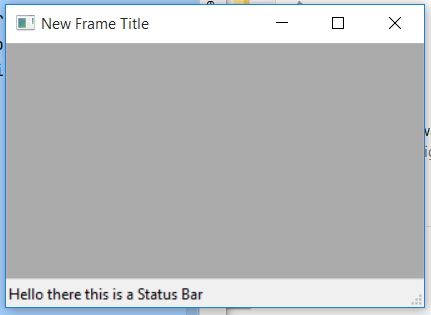wxPython 使用Create()函数的静态线
在这篇文章中,我们将学习与wxPython的wx.StaticLine类相关的Create()方法。静态线就是在对话框中用来分隔各组控件的线。Create()函数通过两步创建静态线。
线条可以是垂直或水平的。此外,并不是所有的端口(特别是wxGTK)都支持指定线的横向方向(例如,水平线的高度),所以为了最大限度的移植,你应该把它指定为DefaultCoord。
语法:wx.StaticLine.Create(parent, id=ID_ANY, pos=DefaultPosition, size=DefaultSize, style=LI_HORIZONTAL, name=StaticLineNameStr)
参数
| 参数 | 输入类型 | 说明 |
|---|---|---|
| parent | wx.Window | 父窗口。必须不是无。 |
| id | wx.WindowID | 窗口标识符。值wx.ID_ANY表示一个默认值。 |
| pos | wx.Point | 窗口的位置。如果指定了wx.DefaultPosition,那么将选择一个默认位置。 |
| size | wx.Size | 尺寸。注意,高度或宽度(取决于线条是水平还是垂直)会被忽略。 |
| style | 长 | 窗口风格(wx.LI_HORIZONTAL或wx.LI_VERTICAL)。 |
| name | 字符串 | 窗口名称 |
代码示例。
import wx
class FrameUI(wx.Frame):
def __init__(self, parent, title):
super(FrameUI, self).__init__(parent, title = title, size =(300, 200))
# function for in-frame components
self.InitUI()
def InitUI(self):
# parent panel for radio box
pnl = wx.Panel(self)
# list of choices
hlist = ['Item One', 'Item Two']
vlist =['Item One', 'Item Two']
# initialize a static line
self.sl = wx.StaticLine()
# add attributes using Create() function
self.sl.Create(pnl, 2, pos =(50, 0), size = (1, 250),
style = wx.LI_VERTICAL)
# set frame in centre
self.Centre()
# set size of frame
self.SetSize((400, 250))
# show output frame
self.Show(True)
# wx App instance
ex = wx.App()
# Example instance
FrameUI(None, 'RadioButton and RadioBox')
ex.MainLoop()
输出窗口。

 极客教程
极客教程